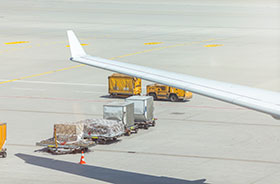GENEVA
,
April 6, 2022
(press release)
–
The International Air Transport Association (IATA) released data for global air cargo markets showing that demand increased in February despite a challenging operating backdrop. Several factors benefitted air cargo in February compared to January. On the demand side, manufacturing activity ramped-up quickly after the early February Lunar New Year holiday. Capacity was positively influenced by the general and progressive relaxation of COVID-19 travel restrictions, reduced flight cancellations due to Omicron-related factors (outside of Asia), and fewer winter weather operational disruptions. Note: We are returning to year-on-year traffic comparisons, instead of comparisons with the 2019 period, unless otherwise noted. Cargo demand is tracking above pre-COVID-19 levels, although capacity is still constrained. The impact of Russia’s invasion of Ukraine had limited effect globally on February’s performance as it occurred very near the end of the month. The negative impacts of war and related sanctions (particularly higher energy costs and reduced trade) will become more visible from March. “Demand for air cargo continued to expand despite growing challenges in the trading environment. That is not likely to be the case in March as the economic consequences of the war in Ukraine take hold. Sanction-related shifts in manufacturing and economic activity, rising oil prices and geopolitical uncertainty will take their toll on air cargo’s performance,” said Willie Walsh, IATA’s Director General. Total Market 100% 2.9% 12.5% -4.9% 53.2% Africa 1.9% 4.6% 8.2% -1.7% 50.2% Asia Pacific 32.4% 3.0% 15.9% -7.1% 59.2% Europe 22.9% 2.2% 10.0% -4.8% 63.6% Latin America 2.2% 21.2% 18.9% 0.9% 47.6% Middle East 13.4% -5.3% 7.2% -7.0% 52.9% North America 27.2% 6.1% 13.4% -3.0% 42.9% 1) % of industry RPKs in 2020 2) Change in load factor vs. the same month in 2019 3) Load Factor Level Asia-Pacific airlines saw their air cargo volumes increase 3.0% in February 2022 compared to the same month in 2021. Available capacity in the region was up 15.5% compared to February 2021, however it remains heavily constrained compared to pre-COVID-19 levels, down 14.6% compared to February 2019. The zero-COVID policy in mainland China and Hong Kong is impacting performance. North American carriers posted a 6.1% increase in cargo volumes in February 2022 compared to February 2021. The ramp up of manufacturing activity in China following the end of the Lunar New Year resulted in growth in the Asia–North America market, with seasonally adjusted volumes rising by 4.3% in February. Capacity was up 13.4% compared to February 2021. European carriers saw a 2.2% increase in cargo volumes in February 2022 compared to the same month in 2021. This was slower than the previous month (6.4%), partially attributable to the war in Ukraine which started at the end of the month. Seasonally adjusted demand on the Asia-Europe route, one of the most affected by the conflict decreased by 2.0% month on month. Capacity was up 10.0% in February 2022 compared to February 2021, and down 11.1% compared to pre-crisis levels (2019). Middle Eastern carriers experienced a 5.3% year-on-year decrease in cargo volumes in February. This was the weakest performance of all regions, which was owing to a deterioration in traffic on several key routes such as Middle East-Asia, and Middle East-North America. Looking forward, there are signs of improvement as data indicate that the region is likely to benefit from traffic being redirected to avoid flying over Russia. Capacity was up 7.2% compared to February 2021. Latin American carriers reported an increase of 21.2% in cargo volumes in February 2022 compared to the 2021 period. This was the strongest performance of all regions. Some of the largest airlines in the region are benefitting from the end of bankruptcy procedures. Capacity in February was up 18.9% compared to the same month in 2021. African airlines saw cargo volumes increase by 4.6% in February 2022 compared to February 2021. Capacity was 8.2% above February 2021 levels. Read the latest Cargo Market Analysis (pdf) For more information, please contact: Corporate Communications Notes for Editors Notes for editors:
AIR CARGO MARKET DETAIL-FEBRUARY 2022
WORLD SHARE (% YEAR ON YEAR)
CTK
ACTK
CLF(%-PT)2
CLF(LEVEL)3
February Regional Performance
Tel: +41 22 770 2967
Email: corpcomms@iata.org
* All content is copyrighted by Industry Intelligence, or the original respective author or source. You may not recirculate, redistrubte or publish the analysis and presentation included in the service without Industry Intelligence's prior written consent. Please review our terms of use.




